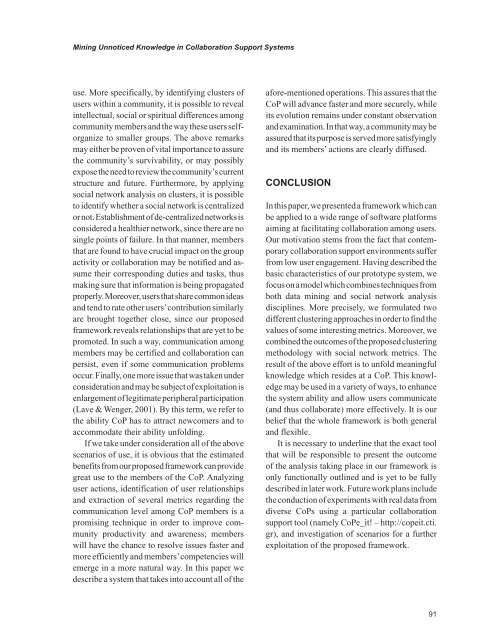Web-based Learning Solutions for Communities of Practice
Web-based Learning Solutions for Communities of Practice
Web-based Learning Solutions for Communities of Practice
Create successful ePaper yourself
Turn your PDF publications into a flip-book with our unique Google optimized e-Paper software.
Mining Unnoticed Knowledge in Collaboration Support Systems<br />
use. More specifically, by identifying clusters <strong>of</strong><br />
users within a community, it is possible to reveal<br />
intellectual, social or spiritual differences among<br />
community members and the way these users sel<strong>for</strong>ganize<br />
to smaller groups. The above remarks<br />
may either be proven <strong>of</strong> vital importance to assure<br />
the community’s survivability, or may possibly<br />
expose the need to review the community’s current<br />
structure and future. Furthermore, by applying<br />
social network analysis on clusters, it is possible<br />
to identify whether a social network is centralized<br />
or not. Establishment <strong>of</strong> de-centralized networks is<br />
considered a healthier network, since there are no<br />
single points <strong>of</strong> failure. In that manner, members<br />
that are found to have crucial impact on the group<br />
activity or collaboration may be notified and assume<br />
their corresponding duties and tasks, thus<br />
making sure that in<strong>for</strong>mation is being propagated<br />
properly. Moreover, users that share common ideas<br />
and tend to rate other users’ contribution similarly<br />
are brought together close, since our proposed<br />
framework reveals relationships that are yet to be<br />
promoted. In such a way, communication among<br />
members may be certified and collaboration can<br />
persist, even if some communication problems<br />
occur. Finally, one more issue that was taken under<br />
consideration and may be subject <strong>of</strong> exploitation is<br />
enlargement <strong>of</strong> legitimate peripheral participation<br />
(Lave & Wenger, 2001). By this term, we refer to<br />
the ability CoP has to attract newcomers and to<br />
accommodate their ability unfolding.<br />
If we take under consideration all <strong>of</strong> the above<br />
scenarios <strong>of</strong> use, it is obvious that the estimated<br />
benefits from our proposed framework can provide<br />
great use to the members <strong>of</strong> the CoP. Analyzing<br />
user actions, identification <strong>of</strong> user relationships<br />
and extraction <strong>of</strong> several metrics regarding the<br />
communication level among CoP members is a<br />
promising technique in order to improve community<br />
productivity and awareness; members<br />
will have the chance to resolve issues faster and<br />
more efficiently and members’ competencies will<br />
emerge in a more natural way. In this paper we<br />
describe a system that takes into account all <strong>of</strong> the<br />
a<strong>for</strong>e-mentioned operations. This assures that the<br />
CoP will advance faster and more securely, while<br />
its evolution remains under constant observation<br />
and examination. In that way, a community may be<br />
assured that its purpose is served more satisfyingly<br />
and its members’ actions are clearly diffused.<br />
CONCLUSION<br />
In this paper, we presented a framework which can<br />
be applied to a wide range <strong>of</strong> s<strong>of</strong>tware plat<strong>for</strong>ms<br />
aiming at facilitating collaboration among users.<br />
Our motivation stems from the fact that contemporary<br />
collaboration support environments suffer<br />
from low user engagement. Having described the<br />
basic characteristics <strong>of</strong> our prototype system, we<br />
focus on a model which combines techniques from<br />
both data mining and social network analysis<br />
disciplines. More precisely, we <strong>for</strong>mulated two<br />
different clustering approaches in order to find the<br />
values <strong>of</strong> some interesting metrics. Moreover, we<br />
combined the outcomes <strong>of</strong> the proposed clustering<br />
methodology with social network metrics. The<br />
result <strong>of</strong> the above ef<strong>for</strong>t is to unfold meaningful<br />
knowledge which resides at a CoP. This knowledge<br />
may be used in a variety <strong>of</strong> ways, to enhance<br />
the system ability and allow users communicate<br />
(and thus collaborate) more effectively. It is our<br />
belief that the whole framework is both general<br />
and flexible.<br />
It is necessary to underline that the exact tool<br />
that will be responsible to present the outcome<br />
<strong>of</strong> the analysis taking place in our framework is<br />
only functionally outlined and is yet to be fully<br />
described in later work. Future work plans include<br />
the conduction <strong>of</strong> experiments with real data from<br />
diverse CoPs using a particular collaboration<br />
support tool (namely CoPe_it! – http://copeit.cti.<br />
gr), and investigation <strong>of</strong> scenarios <strong>for</strong> a further<br />
exploitation <strong>of</strong> the proposed framework.<br />
91



